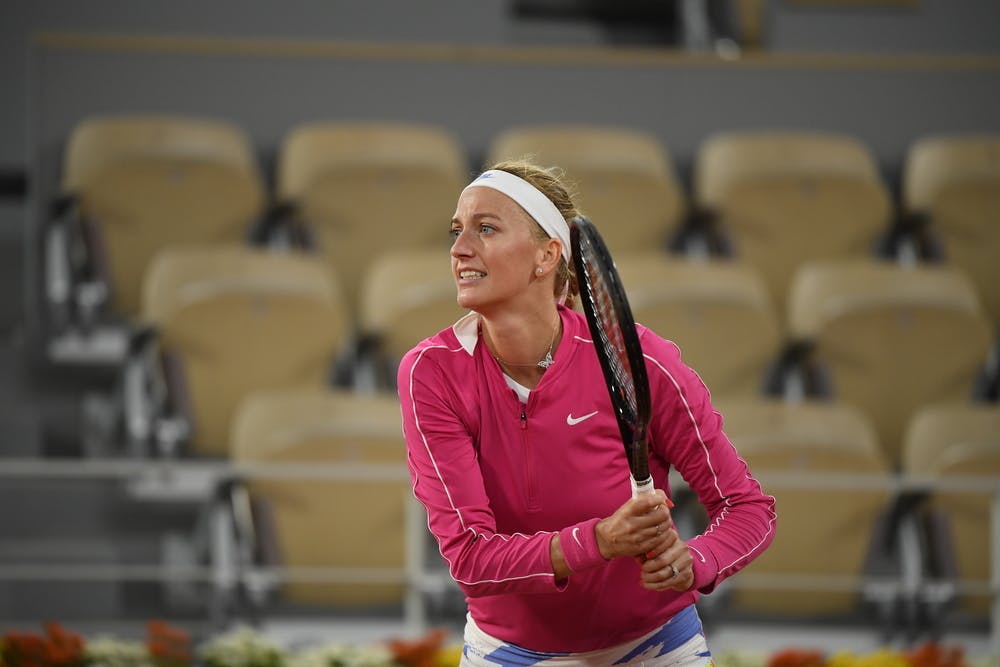Related
Emotions bubble up as Petra finds her way back to quarters

No.7 seed says she's 'ready to run' in a tricky last-eight meeting with Siegemund on Wednesday

When Petra Kvitova reached the semi-finals at Roland-Garros in 2012, she was surprised, delighted and amazed to go so far on a surface she had never previously felt comfortable on.
Eight years on, and with a lifetime of experiences in between, Kvitova is back in the last eight for the first time since, more comfortable on the surface and, whisper it, a massive threat to win the title for the first time.
The 30-year-old, twice a Grand Slam champion at Wimbledon in 2011 and 2014, faces Laura Siegemund of Germany on Wednesday for a place in the semi-finals here once more.
Considering that she played on clay as a youngster in the Czech Republic, Kvitova took time to adjust to the surface as a pro, finding the footing especially difficult.
In the past few years, though, especially since her emotional return to the tour in Paris in 2017, five months after the horrific attack in her home that threatened her life and almost ended her career, she has learned to embrace it and is reaping the rewards.
“I think (it’s) because my movement wasn’t that good,” a smiling Kvitova told rolandgarros.com. “Even though I grew up on the clay, I was never sliding, never playing those topspins as the clay players were. Obviously I had great success on the grass and the hard court. But in the last couple of years I’ve kind of found a way to play on the clay.
“It always takes me some time, but I’m glad that even though I didn’t play many matches on the clay before Roland-Garros, I just practised really well and was thinking about the movement on the clay, and that’s probably helping me.
“I have won some tournaments on clay, too, I won Madrid, I won Prague, I won Stuttgart – they are a little different of course, but Prague is probably the more normal one – but Roland-Garros is different. I’m really trying hard and not thinking too much about it.”
It seems to be working. In her four matches here so far, Kvitova has hit 116 winners, an average of 29 per match, while she’s winning around 70 per cent of points on her first serve.
With her aggressive style of play, Kvitova accepts she will make mistakes, but knows that with a few swings of her racquet, she can make things happen. It's a balance she strikes more often than not, and if it doesn't work, so be it. The highs will outstrip the lows.
This will be Kvitova's 12th Grand Slam quarter-final compared to Siegemund’s one and though it was five years ago, she won her only encounter with the German.
As usual, Kvitova has not been practising on her off days, though the Covid-19 restrictions on players means she has actually been on site more than usual, if only to have some lunch and escape the monotony of being in a hotel.
She’s also played three of her four matches at 11:00am, a time that most players eschew because it’s too early. For Kvitova, an early start is ideal.
“In the Grand Slams, especially, when you’re playing after the men you don’t really know when you’re going to play,” she said. “To be honest, sometimes it’s better to be done and after, it’s all good, and you don’t have to stress anymore. But my last match, I played third after two men’s matches and it was a long time waiting. At the end of the day I don’t really care; when it’s not raining, it’s all good.”
Having a roof over Court Philippe-Chatrier is another advantage for Kvitova, whose hard, flat groundstrokes can be more affected by the wind than someone who plays with a lot of spin.
The one thing Kvitova won’t do is look too far ahead. The talented Siegemund is a major threat on clay, far better than her current ranking of 66. On paper, Kvitova should win, but that pressure can often be an issue.
“It’s not easy to play a lower-ranked player,” she said. “That’s probably why I normally struggle in the first rounds of Grand Slams a little bit, they are always difficult for me to kind of get over because I was always the favourite, everybody putting the pressure on me – me too, of course, I was the one putting pressure on me.
“This is something that wasn’t really easy and it’s still not easy but somehow I found a way to do it. I am just pushing myself a lot to play every point and even though I have nerves and am struggling, I am trying to kind of believe in myself.
“I have been through many, many things in my tennis career and in my life too, I know that I can turn it around in a few points in a match.”
Against Siegemund, who loves to play drop shots and break up her opponent's rhythm, Kvitova said she will be ready, and ready to run.
As she has said many times in the past three years, Kvitova has “already won her biggest fight”.
After that, everything else is a breeze.